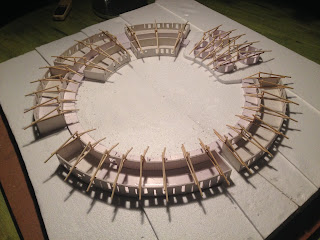Stage 1: Site Study
Since the proposed school can be located in any out of a list of countries in Africa, we were not given a specific site. So, we had to work with two points of focus:
1. The site was in Africa
ii. It had tropical savannah climate.
It doesn't sound like much, but even something like this can take lots of research.
First of all, I have never been to Africa. Nor do I know anything about it's architecture. I was relying on the Internet, and the Internet can be pretty annoying sometimes.
Let's start out with the first point. Africa. What does that mean? What needs to be studied?
What I did first was study the traditional forms of architecture that prevail in Africa. No matter how modern we become, it's not very respectful to replace thousands of years of knowledge with just a few decades of technological know-how. If Africans have been building their structures a certain way for a long time, there must be a reason for it.
One of my sources was africanvernaculararchitecture.com. Following are some pictures which might help you get a better understanding of architecture in Africa:
I didn't go much into the details at the pictures stage, because sometimes, not knowing too much helps you learn. For example, from here I learnt (without readind a single line of text), that mud would be a more feasible building material than bamboo (which would have been ideal for, say, Bali). Also, I learnt that that there's a fluidity in vernacular architecture design, that voids in the walls are a repeating characteristic, thatch-roofing may just work etc. These were just clues picked up by my subconscious.
But the pictures couldn't dictate my design. My design needed to be my own, and to make informed decisions regarding my design, I started with the online research phase. And this included lots and lots of text.
The truth is that this stage can go on forever. There's no end. You might be halfway through drafting your design and then you go, Oh, can this tree really be here? And that leads to an hour on the Internet researching the fauna of Africa.
So, what did I learn during this stage?
1. That I was right. Mud really is my best friend. I decided to go with adobe brick construction with mud plastering.
2. That Africa isn't the jungle we all believe it to be. In fact, it's got lots of grasslands and deserts, which meant that picking out trees would be a task.
3. Walled compounds fit better with the context.
4. Water is a huge problem in Africa, which meant finding a solution to provide drinking water for the students in the school.
Four points of focus. That's enough to work with for now. Stay tuned to know how these four points eventually affected my design.
Sources:
www.africanvernaculararchitecture.com
http://www.architectural-review.com/essays/the-fabulous-diversity-of-vernacular-architecture-along-the-west-coast-of-africa/8603280.article
Pinterest
and more....
Since the proposed school can be located in any out of a list of countries in Africa, we were not given a specific site. So, we had to work with two points of focus:
1. The site was in Africa
ii. It had tropical savannah climate.
It doesn't sound like much, but even something like this can take lots of research.
First of all, I have never been to Africa. Nor do I know anything about it's architecture. I was relying on the Internet, and the Internet can be pretty annoying sometimes.
Let's start out with the first point. Africa. What does that mean? What needs to be studied?
What I did first was study the traditional forms of architecture that prevail in Africa. No matter how modern we become, it's not very respectful to replace thousands of years of knowledge with just a few decades of technological know-how. If Africans have been building their structures a certain way for a long time, there must be a reason for it.
One of my sources was africanvernaculararchitecture.com. Following are some pictures which might help you get a better understanding of architecture in Africa:
I didn't go much into the details at the pictures stage, because sometimes, not knowing too much helps you learn. For example, from here I learnt (without readind a single line of text), that mud would be a more feasible building material than bamboo (which would have been ideal for, say, Bali). Also, I learnt that that there's a fluidity in vernacular architecture design, that voids in the walls are a repeating characteristic, thatch-roofing may just work etc. These were just clues picked up by my subconscious.
But the pictures couldn't dictate my design. My design needed to be my own, and to make informed decisions regarding my design, I started with the online research phase. And this included lots and lots of text.
The truth is that this stage can go on forever. There's no end. You might be halfway through drafting your design and then you go, Oh, can this tree really be here? And that leads to an hour on the Internet researching the fauna of Africa.
So, what did I learn during this stage?
1. That I was right. Mud really is my best friend. I decided to go with adobe brick construction with mud plastering.
2. That Africa isn't the jungle we all believe it to be. In fact, it's got lots of grasslands and deserts, which meant that picking out trees would be a task.
3. Walled compounds fit better with the context.
4. Water is a huge problem in Africa, which meant finding a solution to provide drinking water for the students in the school.
Four points of focus. That's enough to work with for now. Stay tuned to know how these four points eventually affected my design.
Sources:
www.africanvernaculararchitecture.com
http://www.architectural-review.com/essays/the-fabulous-diversity-of-vernacular-architecture-along-the-west-coast-of-africa/8603280.article
and more....




















































